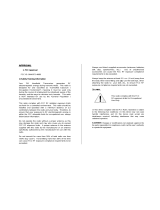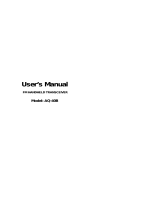Page is loading ...

User’s Manual
Land Mobile Radio (LMR)
Model: ATP-100

APPROVAL
1. FCC Approval
FCC ID: ONKATP-100
1) Safety Training Information
Your FM Handheld Transceiver generates RF
electromagnetic energy during transmit mode. This radio is
designed for and classified as “Controlled Exposure /
Occupation Environment”, meaning it must be used only
during the course of employment by individuals aware of the
hazards, and the ways to minimize such hazards.
This radio is NOT intended for use by the “General
Population/Uncontrolled Environment.
This radio complies with FCC RF radiation exposure limits
set forth for a controlled environment. This radio should be
installed and operated with a minimum distance of 2.5
centimeters between the radio and your body. Therefore, to
ensure that your exposure to RF electromagnetic energy is
within the FCC allowable limits for occupational use, always
follow below information.
Do not operate the radio without a proper antenna as this
may damage the radio and may also cause you to exceed
FCC RF exposure limits. A proper antenna is the antenna
supplied with this radio by the manufacturer or an antenna
specifically authorized by the manufacturer for use with this
radio.
Do not transmit for more than 50% of total radio use time
(“50% duty cycle”). Transmitting more than 50% of the time
can cause FCC RF exposure compliance requirements to be
exceeded.
Always use Airtech supplied accessories (antennas, batteries,
belt clips, speaker/mics, etc.). Use of unauthorized
accessories can cause the FCC RF exposure compliance
requirements to be exceeded.
Always keep the antenna at least 2.5 cm (1 inch) away from
the body when transmitting and only use the belt-clips, when
attaching the radio to your belt, etc., to ensure FCC RF
exposure compliance requirements are not exceeded.
2) LABEL
3) This device complies with the FCC Rules. Operation is subject
to the following two conditions: (1) this device may not cause
harmful interference, and (2) this device must accept any
interference received, including interference that may cause
undesired operation.
CAUTION: Changes or modifications not expressly approved by
the party responsible for compliance could void the user’s authority
to operate the equipment.
This radio complies with the FCC
RF exposure limits for Occupational
Use Only.
3

RF Exposure
Tests for SAR are conducted using standard operating
positions specified by the FCC with the phone
transmitting at its highest certified power level in all
tested frequency bands. Although the SAR is
determined at the highest certified power level, the
actual SAR level of the phone while operation can be
well below the maximum value. This is because the
phone is designed to operate at multiple power levels
so as to use only the power required to reach the
network. In general, the closer you are to a wireless
base station antenna, the lower the power output.
Before a phone model is available for sale to the public,
it must be tested and certified to the FCC that it does
not exceed the limit established by the government-
adopted requirement for safe exposure, The tests are
performed in positions and location (e.g., at the ear and
worn on the body) as required by the FCC for each
model. (Body-worn measurements may differ among
phone models, depending upon available accessories
and FCC requirements). While there may be
differences between the SAR levels of various phones
and at various positions, they all meet the government
requirement for safe exposure.
For body worn operation, to maintain compliance with
FCC RF exposure guidelines, use only accessories that
contain no metallic components and provide a
separation distance of 15mm (0.6 inches) to the body.
Use of other accessories may violate FCC RF exposure
guidelines and should be avoided.
It is designed and manufactured not to exceed the
emission limits for exposure to radio frequency (RF)
energy set by the Federal Communications
Commission of the U.S. Government. These limits are
part of comprehensive guidelines and establish
permitted levels of RF energy for the general population.
The guidelines are based on the safety standards
previously set by both U.S. and international standards
bodies:
This EUT has been shown to be capable of compliance
for localized specific absorption rate (SAR) for
uncontrolled environment/general population exposure
limits specified in ANSI/IEE Std. C95.1-1992 and had
been tested in accordance with the measurement
procedures specified in FCC/OET Bulletin 65
Supplement C (2001) and IEE Std. 1528-200X (Draft6.5,
January 2002).
Ministry of Health (Canada), Safety Code 6. The
standards include a substantial safety margin designed
to assure the safety of all persons, regardless of age
and health. The exposure standard for wireless mobile
phones employs a unit of measurement know as the
Specific Absorption Rate, or SAR. The SAR limit set by
the FCC is 1.6W/kg*.

CONTENTS
GENERAL FEATURES.................................................4
UNPACKING.................................................................5
OPTIONAL ACCESSORIES.........................................5
GETTING READY.........................................................2
DESCRIPTION..............................................................3
OPERATION.................................................................4
CHARGER AND BATTERY..........................................5
General Features
1. Ultra compact design & size
(102(W)x50(H)x36(D), 310g with high capable battery)
2. Heavy duty durable construction
3. 256 channels
4. 38 CTCSS/ 83 CDCSS/ 83 INVERR CDCSS
5. PC Programmable, transferable by cloning
6. Time-out timer (TOT)
7. Busy Lockout (BCLO)
8. Battery saving mode
9. Low battery alert
10. DTMF ANI
11. Transmit output power High/Low
12. DC 7.5V LI-1700 battery

Unpacking
Unpack and check that all items have been enclosed.
Packing contents: ①radio ②antenna ③battery pack
(1,700 mAH) ④belt clip ⑤hand strap ⑥charger ⑦user’s
manual
Optional Accessories
1. External speaker/microphone
2. Additional battery pack
Getting Ready
1. Installation and Removal, Belt Clip
Installation: Align the belt clip with the
plastic slots of the battery pack. Slide
the belt clip onto the battery pack,
pushing firmly until a click heard.
Removal: Hold up the belt clip release tab with a
fingernail or a coin (or like instrument). While
holding up the release tab, slide the belt clip out
and away from the battery pack.
2. Installation and Removal, Battery Pack
Installation: Turn off the transceiver. Hold the
transceiver with the back of the unit facing up.
Place the battery pack against the back of the
transceiver so that the tabs on the transceiver engage
the four openings in the battery pack. Slide the battery
pack toward the top of the transceiver until a click heard.
Removal: Turn off the transceiver. Hold the radio with
the back of the unit facing up. With the thumbnail of your
other hand slide the latch lever down. While holding the
latch lever down, slide the battery pack down toward the
bottom of the transceiver. Separate the battery pack from
the transceiver.
3. Installation Antenna
Rotate the antenna clockwise until it is seated firmly.
*. Before starting operation, make sure the battery is fully
charged.

Description
Emergency
Power on / off and Volume Control Switch
Turn the transceiver on by rotating power on / off and volume
control switch clockwise and control the volume.
Helical Antenna.
Tx / Rx Indicate LED (3 colors)
On Transmitting
Red
Blinking Low battery
On Receiving, monitoring
Green
Blinking Different sub-tone when receiving
Orange On
Initializing, programming and
cloning
External Earphone/MIC and Programming Jack Socket
Speaker
Tx Output H/L
Function
Squelch (SQ)
Channel Select Button
Select the desired channel with pressing Up and Down button,
pressing and holding down more than 1 second makes the channel
moving fast. And you can choose On or Off in function mode
PTT(Push To Talk) Button
Hold down to transmit, release to receive.
Monitor Button
Press to monitor. Holding down over 2 seconds keeps monitoring
function on, and press shortly again or PTT Button to stop.

Operation
1. Power on / off and Volume Control:
Rotate the Power on/off and Volume Control Switch
clockwise to turn power on, then the LED lights orange
and power–up tone is generated after about on second,
indicating the transceiver has passed the self–diagnostic.
When you turn on the transceiver, it comes same
channel and function with your last using. Rotate this
switch clockwise to increase the volume or
counterclockwise to reduce the volume. Rotate it
counterclockwise fully to turn power off.
2. Channel Selection:
Press up/down button, to desired channel.
3. Transmit:
Hold down the PTT Button and talk into the MIC at 1-2
in distance. The LED lights red on transmitting. Release
the PTT button to receive.
4. Receive:
Choose the desired channel by press up/down button .
The LED lights green on receiving. In case the signal
doesn’t match the sub–tone the green LED will blink.
5. Monitor:
Press to monitor. Pressing the monitor button for more
than 2 seconds will cause continuous monitor condition.
To release the monitor mode, press and release the
monitor button quickly.
6. Scan
1). Press and hold the function button and up
button to start scan.
a. Scan type will be priority type, else normal type
If the radio is programmed in priority channel,
scan.
b. If priority type scan, the scan has stopped on a
non priority channel there will be skips in the
audio while the radio checks the priority
channel. During priority scanning you may talk
c. on the last busy channel by pressing the
function button and up button. After completing
the conversation, restart scan.
d. To delete a busy channel from scan, press
down button. If the up button is pressed, the
scan will restart but stop again if the channel
continues to be busy.
7. Transmit operation during scan
. If the radio is programmed in ptt channel at
scanning is home channel: TX will occur on the
channel the scan started.
. If the radio is programmed in ptt channel at
scanning is last busy channel: TX will occur on the last
busy channel
8. TX ANI
If the radio was initially programmed for this feature
pressing the PTT will cause a DTMF code to be send
that can identify the sending radio.
9. 2/5 Tone Decode (Selcall)
During initial radio programming by the technician this radio
can be configured for several different types of decode
operation. If a channel is selected that has Selcall
activated the radio will be muted until the proper signal is
received. When this occurs the radio can sound a ringing
type alert signal or a voice message maybe heard.
Depending upon the initial programming, pressing the
PTT may cause an automatic identifier to be sent. When
programmed for Selcall pressing the monitor and function
buttons at the same time can cause the Selcall mode to
be cancelled and generate an automatic identification.
Please have your radio technician or dispatcher fully
explain this operation.

Charger and Battery
1. Battery (Li-ion)
Voltage DC 7.5V
Duty time (5-5-90) Over 10 hrs
2. Charger
Input power (90~250VAC)
Operating temperature 10-30 deg. C
Connect the charger to an appropriate outlet (90~250 VAC).
Turn the transceiver power off and place the radio into the
front socket of the charger. The red light illuminates during
charging and the green light comes on when the charge is
complete. When you place two batteries in the charger at the
same time, the front battery will charge first. The rear battery
will begin charging when the front battery charge is complete.
On Charging
Red
Blinking Abnormal battery
Green On Fully charged
On Stand-by for charging (rear cup) Orange
Blinking Discharging
When you put a battery in the rear cup of the charger the
charger checks the voltage. If voltage is over 7.4V, the
charger starts discharging for 4 minutes then checks
again. If voltage is still more than 7V, it discharges until
the voltage is 6V then starts charging.
/



